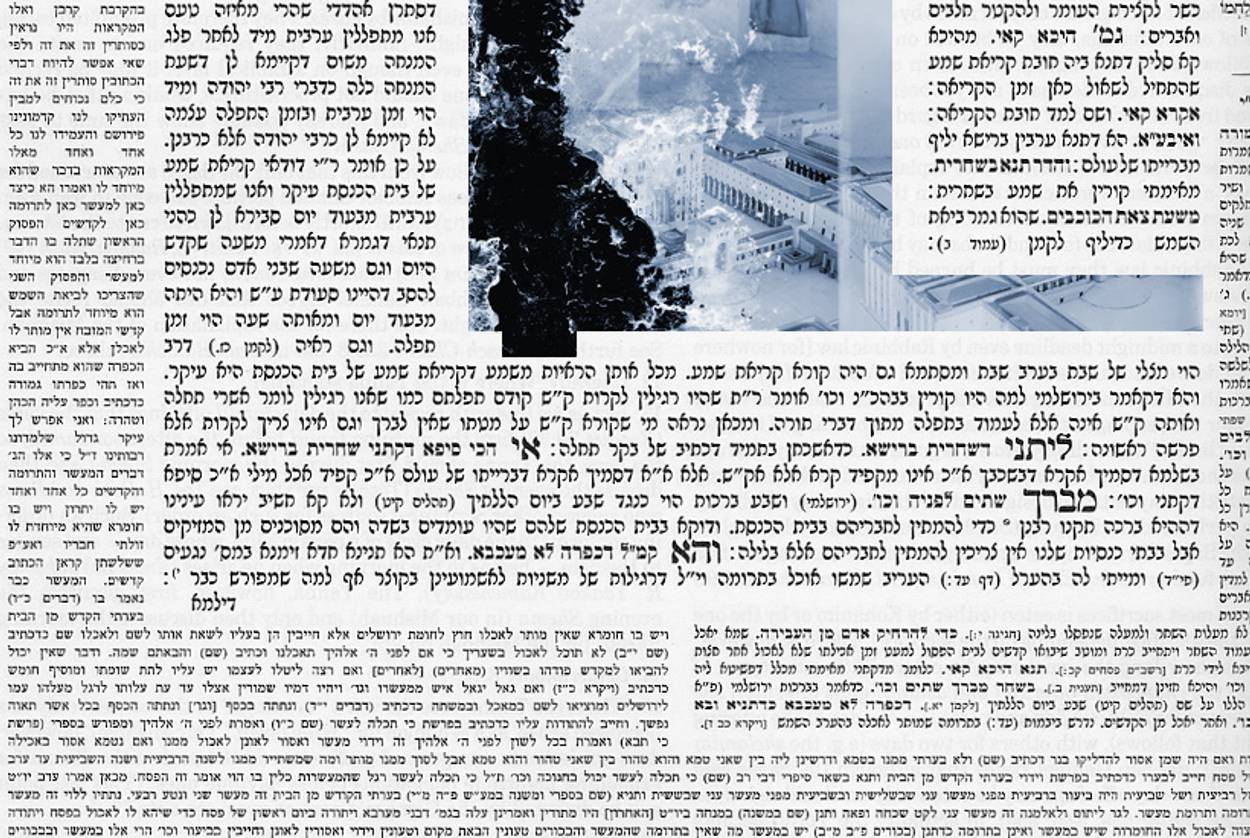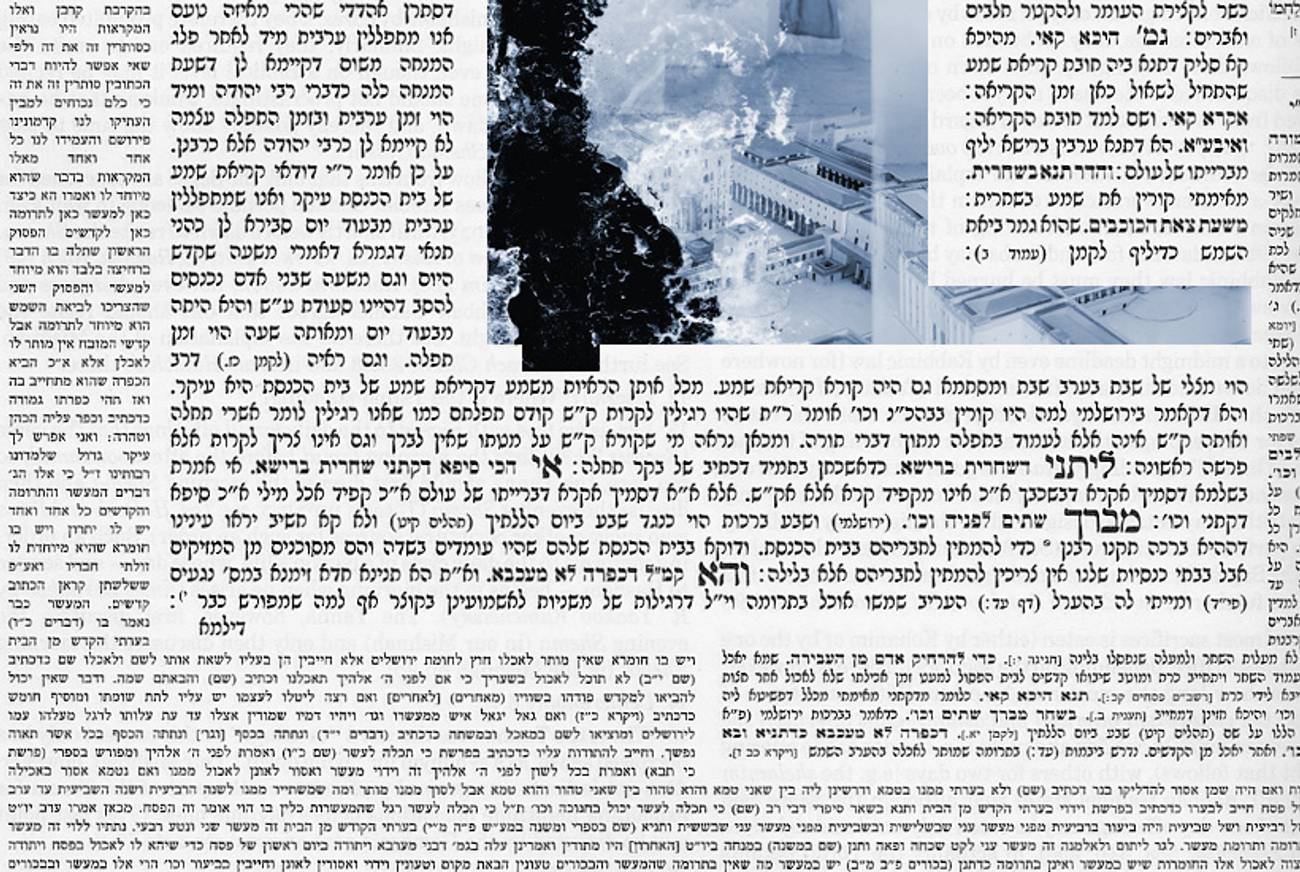Miraculous Architecture of the First Temple Leads to Religious Sectarianism in the Second
To the Talmudic rabbis, a miracle is more plausible than the notion that their sources were incorrect




Literary critic Adam Kirsch is reading a page of Talmud a day, along with Jews around the world.
Imagine that you wanted to build an exact duplicate of your house, and you hired an architect to do the job. But the architect isn’t allowed to see the building she was supposed to duplicate, and you aren’t allowed to make any blueprints or drawings of it: All you can do is describe its dimensions in words. Something like this is the challenge facing the rabbis when they try to imagine the Holy Temple, which stood in Jerusalem for centuries before the Romans destroyed it in 70 C.E. The Amoraim had never seen the structure they were trying to describe. All they had were conflicting reports from a variety of rabbinic sources, which had to be reconciled with each other and with the biblical description of the Temple. It’s no wonder, then, that the accounts of the Temple in Tractate Yoma, which Daf Yomi readers have been exploring this week, are so inconsistent and hard to follow.
Take the question of the Temple courtyard, which arises in Yoma 15b. It is known that there was a chamber in each of the four corners of this courtyard. According to one mishna, their names were the Chamber of the Lambs, where lambs awaiting sacrifice were kept; the Chamber of the Seals, where Jewish pilgrims paid for their sacrificial animals and received a special seal as a kind of receipt; the Chamber of the Hall of the Hearth, where a fire was kept burning to keep the priests warm; and the Chamber of the Shewbread, where the sacred loaves were baked. But another mishna has a different tally. According to this source, there were chambers for the lambs and the shrewbread. But the other two chambers were the Hall of Immersion, where the priests entered the ritual bath, and a storage chamber, where the Maccabees kept the altar-stones that had been defiled by Antiochus.
The Gemara has no basis for deciding which one of these descriptions is correct, so it simply records them both. Elsewhere, when different sources offer apparently irreconcilable information about the Temple, the rabbis declare that a miracle allows them both to be accurate. This is what happens in Yoma 21a, when the Gemara mentions the Ark of the Covenant, which was the heart of the First Temple. According to the Book of Kings, the Holy of Holies, the room where the Ark was kept, measured 20 cubits across. Yet a rabbinic tradition has it that there were 10 cubits to spare on either side of the Ark. For both these things to be true, the Ark would have to take up no space at all. And that is exactly the solution the Gemara endorses: One of the miracles of the Temple was that “the place of the Ark is not included in the measurement of the Holy of Holies.” To the rabbis, a miracle is more plausible than the notion that one or both of the their sources was incorrect.
In fact, there were 10 miracles performed in the Temple, a mishna records. Yet these are not the kind of miracles we read about the Book of Exodus: The rabbis do not expect us to believe that visitors to the Temple saw a pillar of fire or heard the voice of God. Rather, they are miracles of amenity, which allowed the Temple to function smoothly despite the sheer volume of visitors and business. One might expect, for instance, that a place where cattle are constantly being slaughtered would smell like the stockyards of Chicago. But “no woman miscarried from the aroma of the sacrificial meat,” the rabbis tell us, “and no fly was seen in the slaughterhouse.” Again, you might think that a structure where up to a million Jews gathered for the major festivals would be crowded. However, we read that the people “stand crowded but bow spaced”: No matter how packed the crowd, everyone had enough room to bow down and pray.
Another miracle relates directly to the main subject of this week’s Daf Yomi reading, the duties of the high priest on Yom Kippur. As we have seen, the high priest would be secluded for the week before the holy day, to keep him safe from ritual impurity. A seminal emission, for instance, would put the priest into the category known as a “zav” and render him unfit for performing the Temple service. But miraculously, “a seminal emission did not befall the high priest on Yom Kippur” in all the long history of the Temple.
This did not mean, however, that the matter was left up to chance. The high priest was forbidden to eat foods that, according to the medical wisdom of the time, might lead to a discharge of semen. The rabbis disagree about exactly which foods fall into this category, but they mention several possibilities, including eggs, fatty meat, and white wine. On the other hand, they would deliberately feed the high priest food with a laxative effect, in order to empty his bowels so that he wouldn’t need to defecate on Yom Kippur.
This intense focus on the high priest’s body makes clear that, for the Judaism of the Temple, the spiritual and the corporeal were never separated. This was a faith based on the slaughtering of animals and the sprinkling of blood, and it had no room for squeamishness in the face of bodily realities. Take, for instance, the duty of the high priest to stay awake the whole night before Yom Kippur. In an ideal world, this would happen automatically, because he would be spending the night in meditation and repentance. In fact, the Talmud makes clear, high priests had a tendency to fall asleep, and measures had to be taken to prevent this: “The young priests would snap the middle finger before him” and periodically roust him out of bed to stand on the chilly stone floor.
In another passage, we learn that the high priest was kept busy with lectures and reading: “If he was a scholar, he would teach Torah. If he was not a scholar, Torah scholars would teach Torah before him. And if he was accustomed to read the Bible, he would read, and if not, they would read the Bible before him.” This practical advice suddenly opens up an unexpected perspective on the high priesthood. The very name Kohen Gadol suggests a holy and pious man; yet here we learn that many high priests not only were not Torah scholars, but they never even read the Bible.
In fact, in Yoma 18a, the Mishna contemplates the possibility of a high priest who didn’t know how to read at all. In that case, he would be unable to read the description of his duties on the holy day, and a group of “elders” would have to come in to instruct him. The Gemara itself wonders at this: “However, is it conceivable that perhaps the high priest did not learn to read? Do we appoint a high priest of that sort?” After all, doesn’t tradition say that the high priest must be greater than his fellow priests “in strength, in beauty, in wisdom, and in wealth”?
During the days of the First Temple, the Gemara explains, this might have been true. But the Second Temple—the one that the returning Jewish exiles built in the late 6th century B.C.E.—was inferior to the first in every respect, and this included the quality of its priests. Reading Josephus’ The Jewish War, which recounts the history of the Jewish kingdom in the years before the Temple’s destruction, it becomes clear that the high priesthood was a political appointment, frequently used by the Jewish kings to reward allies or solicit bribes. In the Gemara, Rav Asi mentions one such occasion, when “Marta, daughter of Baitos, brought a half-se’a of dinars to King Yannai”—known in English as Alexander Jannaeus, he reigned in the early first century B.C.E.—in exchange for appointing one Yehoshua ben Gamla as high priest.
As if politics and money weren’t bad enough, the high priesthood was also afflicted by religious sectarianism. Judaism in the Second Temple period was divided between the Pharisees, the mainstream ancestors of rabbinic Judaism, and the heretical Sadducees, whose exact beliefs remain mysterious. As often happens, however, theological differences became symbolized in minute ritual distinctions. The Pharisees believed that on Yom Kippur, the high priest should light his pan of incense inside the Holy of Holies, while the Sadducees thought he should light it outside the Holy of Holies and bring it in already burning. The Pharisees thus made each high priest take a vow that he would follow the official protocol and not engage in any Sadducee deviations. The necessity of this, the Gemara tells us, made both the Pharisees and the high priest himself weep for shame.
But on at least one occasion, a Sadducee high priest slipped past the safety net and managed to light the incense outside. His punishment was immediate: As soon as he emerged from the Holy of Holies, Rabbi Chiyya tells us, “a type of sound was heard in the courtyard, as an angel came and struck him in the face.” When examined, he was found to have “the likeness of the footprint of a calf between his shoulders”—this could only have come from an angel’s foot, since angels had cowlike feet. And within a few days, the errant Sadducee died “and was laid out in the garbage,” denied a proper burial. Once again, we see that the Talmud demands not just faith in God but correct action. It’s because the Temple service was a life-and-death matter that the rabbis went to such lengths to get it right.
***
To listen to a Vox Tablet conversation with literary critic Adam Kirsch about his Daf Yomi study, click here
Adam Kirsch is a poet and literary critic, whose books include The People and the Books: 18 Classics of Jewish Literature.
Adam Kirsch is a poet and literary critic, whose books include The People and the Books: 18 Classics of Jewish Literature.